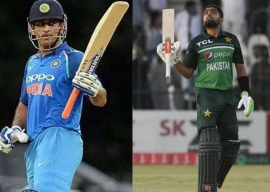‘Tu samnay hai, kis tarha tujhay dekhun, nazara darmiyan hai’
On Saturday evening, The Second Floor (T2F) was packed with enthralled readers absorbed in the masterful dramatic recital of Qurratulain Haider’s short-story Nazara Darmiyan Hai. The story is nothing short of a deep plunge into the quandary of human emotions. Punctuated by tastefully selected instrumentals, the dramatic reading of this afsana was yet another triumph for Zambeel Dramatic Readings — the trio of Saife Hasan, Asma Mundrawala and Mahvash Faruqi, which holds regular readings from notable Urdu works to rekindle interest and celebrate literature with a touch of theatrics.
Love devoid of union and a union devoid of love — this is the theme of Haider’s Nazara Darmiyan Hai. The poignant notes of a violin rang through the room as Khursheed Alam was reminded of Pahoja — the Parsi music teacher he met in Paris. She remained a part of his life after even her death; not as a woman who brightened his dreary days, but as a painful memory he could not rid himself of. He married Almaas Begum in a curious turn of fate. This duality of pleasure and pain has been orchestrated to perfection by the author.
Haider’s love affair with the pen only just begins here. She wrote short stories which rivaled those by Krishan Chander and Ismat Chughtai, but she mastered the novel like no Urdu writer ever did. Aag Ka Darya, her magnum opus, is the novel which is also known to be the crowning glory of Urdu literature. The plot is spine-tingling and simply genius. It traces the circumstances of a single human soul across four eras in history — the modern, the medieval, the pre-medieval, and the colonial. In these different eras, the soul materialises into different characters. Intrinsically, however, it remains the same.
It wouldn’t be wrong to assert that no Urdu writer has been able to pen down a plot as extensive as that of Aag Ka Darya. Asif Farrukhi, renowned writer and critic, invited to present his insight on the author’s work, told The Express Tribune: “Qurratulain Haider was a writer whose imagination knew no bounds. It was for this very reason that she attempted to write this novel. She needed several pages to put all that imagination into words.” Although Haider is best known for Aag Ka Darya, she has also written other novels including Chandni Begum and Aakhir-e-Shab Ke Hamsafar. The latter won her the Jnanpith Award, which is one of the highest literary honours in India.
The soaring tide of neglect towards Urdu literature has wiped away the rich legacy of Haider’s work, as Farrukhi said: “Literature used to be a household affair. People in Karachi used to flock outside their houses and discuss novels and poems by new writers. The enthusiasm for good writing is now dead, which is why hardly any Urdu writer proceeds with something as ambitious as a novel.”
Zambeel Dramatic Readings engages in the much-needed exercise of picking up dusty literary volumes from forgotten shelves, opening their yellowed pages and presenting them in a refreshing manner. Here’s to hoping that it continues to hold such readings.
Published in The Express Tribune, October 9th, 2012.
Like Life & Style on Facebook and follow at @ETLifeandStyle for the latest in fashion, gossip, entertainment
1734776708-0/Untitled-(8)1734776708-0-405x300.webp)
1734773637-0/Untitled-(7)1734773637-0-165x106.webp)
1734772637-0/Untitled-(6)1734772637-0-165x106.webp)
1734769757-0/Untitled-(4)1734769757-0-165x106.webp)
1734765764-0/Untitled-(3)1734765764-0-165x106.webp)


1734762375-0/Untitled-design-(51)1734762375-0-270x192.webp)







1734587529-0/Express-Tribune-(1)1734587529-0-270x192.webp)
1734606611-0/Express-Tribune-(8)1734606611-0-270x192.webp)






COMMENTS
Comments are moderated and generally will be posted if they are on-topic and not abusive.
For more information, please see our Comments FAQ